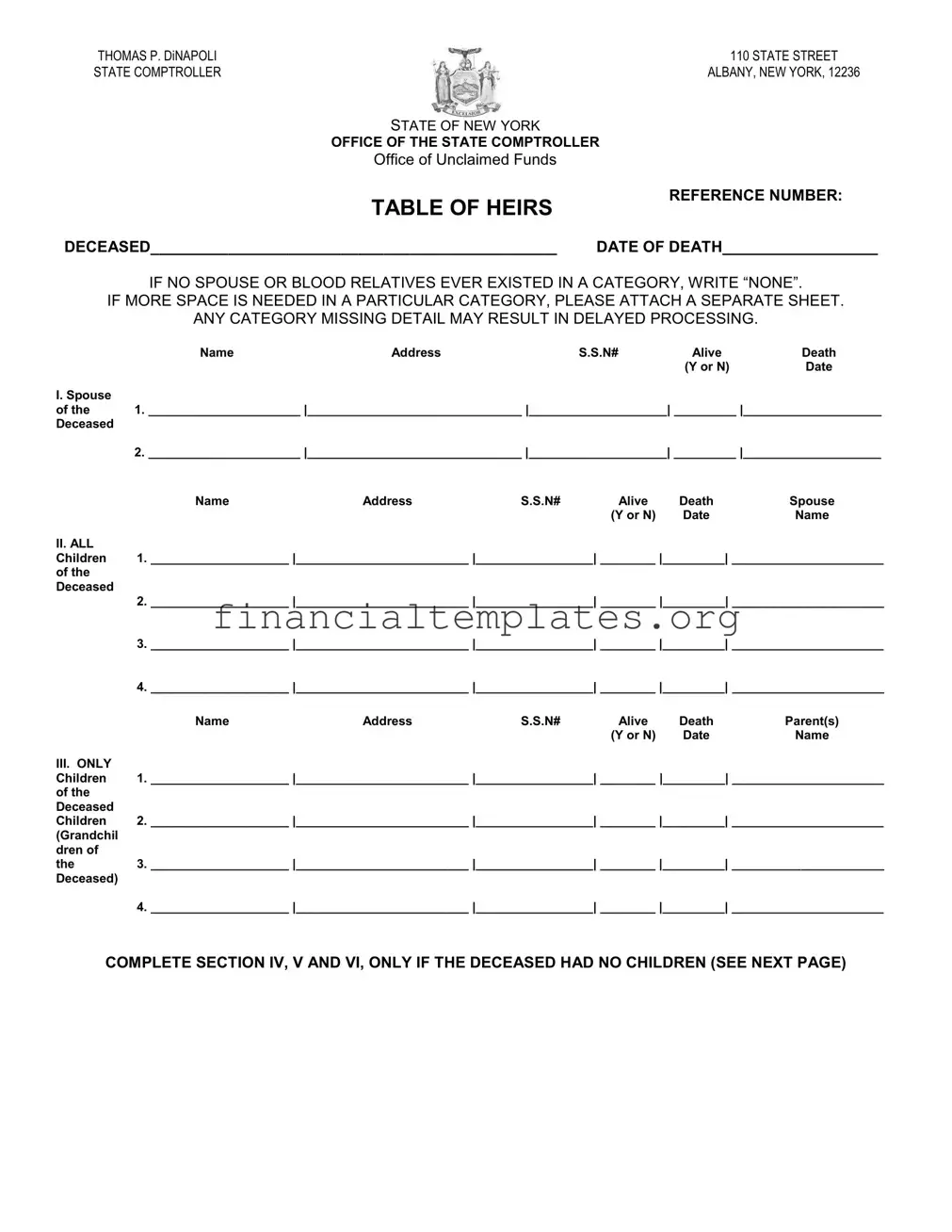THOMAS P. DINAPOLI |
|
|
|
|
110 STATE STREET |
STATE COMPTROLLER |
|
|
|
ALBANY, NEW YORK, 12236 |
|
|
STATE OF NEW YORK |
|
|
|
|
|
OFFICE OF THE STATE COMPTROLLER |
|
|
|
|
Office of Unclaimed Funds |
|
|
|
|
|
TABLE OF HEIRS |
|
REFERENCE NUMBER: |
|
|
|
|
|
DECEASED_______________________________________________ |
DATE OF DEATH__________________ |
|
IF NO SPOUSE OR BLOOD RELATIVES EVER EXISTED IN A CATEGORY, WRITE “NONE”. |
IF MORE SPACE IS NEEDED IN A PARTICULAR CATEGORY, PLEASE ATTACH A SEPARATE SHEET. |
|
ANY CATEGORY MISSING DETAIL MAY RESULT IN DELAYED PROCESSING. |
|
Name |
Address |
|
S.S.N# |
Alive |
Death |
|
|
|
|
|
(Y or N) |
Date |
I. Spouse |
|
|
|
|
|
|
of the |
1. ______________________ |_______________________________ |____________________| _________ |____________________ |
Deceased |
|
|
|
|
|
|
|
2. ______________________ |_______________________________ |____________________| _________ |____________________ |
|
Name |
Address |
S.S.N# |
Alive |
Death |
Spouse |
|
|
|
|
(Y or N) |
Date |
Name |
II. ALL |
|
|
|
|
|
|
Children |
1. ____________________ |_________________________ |_________________| ________ |_________| ______________________ |
of the |
|
|
|
|
|
|
Deceased |
|
|
|
|
|
|
2.____________________ |_________________________ |_________________| ________ |_________| ______________________
3.____________________ |_________________________ |_________________| ________ |_________| ______________________
4.____________________ |_________________________ |_________________| ________ |_________| ______________________
|
Name |
Address |
S.S.N# |
Alive |
Death |
Parent(s) |
|
|
|
|
(Y or N) |
Date |
Name |
III. ONLY |
|
|
|
|
|
|
Children |
1. ____________________ |_________________________ |_________________| ________ |_________| ______________________ |
of the |
|
|
|
|
|
|
Deceased |
|
|
|
|
|
|
Children |
2. ____________________ |_________________________ |_________________| ________ |_________| ______________________ |
(Grandchil |
|
|
|
|
|
|
dren of |
|
|
|
|
|
|
the |
3. ____________________ |_________________________ |_________________| ________ |_________| ______________________ |
Deceased) |
|
|
|
|
|
|
4. ____________________ |_________________________ |_________________| ________ |_________| ______________________
COMPLETE SECTION IV, V AND VI, ONLY IF THE DECEASED HAD NO CHILDREN (SEE NEXT PAGE)
________________________________________________
Social Security / Taxpayer Identification Number
TABLE OF HEIRS
Page -2-
|
Name |
Address |
|
S.S.N# |
Alive |
Death |
|
|
|
|
|
(Y or N) |
Date |
IV. |
|
|
|
|
|
|
Parents of |
1. ______________________ |_______________________________ |____________________| _________ |____________________ |
the |
|
|
|
|
|
|
Deceased |
|
|
|
|
|
|
|
2. ______________________ |_______________________________ |____________________| _________ |____________________ |
|
Name |
Address |
S.S.N# |
Alive |
Death |
Spouse |
|
|
|
|
(Y or N) |
Date |
Name |
V. ALL |
|
|
|
|
|
|
Brothers |
1. ____________________ |_________________________ |_________________| ________ |_________| ______________________ |
and |
|
|
|
|
|
|
Sisters of |
|
|
|
|
|
|
the |
2. ____________________ |_________________________ |_________________| ________ |_________| ______________________ |
Deceased |
|
|
|
|
|
|
3.____________________ |_________________________ |_________________| ________ |_________| ______________________
4.____________________ |_________________________ |_________________| ________|_________| ______________________
|
Name |
Address |
S.S.N# |
Alive |
Death |
Parent(s) |
|
|
|
|
(Y or N) |
Date |
Name |
VI. ONLY |
|
|
|
|
|
|
Children |
1. ____________________ |_________________________ |_________________| ________ |_________| ______________________ |
of the |
|
|
|
|
|
|
Deceased |
|
|
|
|
|
|
Brothers |
2. ____________________ |_________________________ |_________________| ________ |_________| ______________________ |
and |
|
|
|
|
|
|
Sisters |
|
|
|
|
|
|
3.____________________ |_________________________ |_________________| ________ |_________| ______________________
4.____________________ |_________________________ |_________________| ________ |_________| ______________________
This table was completed by ___________________________, who is related to the decedent as a __________________________,
and who resides at ________________________________________in the county of __________________________________ and
State of ________________________, and, who being duly sworn, declares under penalty of perjury that the above information is true
and correct to the best of her/his knowledge.
________________________________________________
Signature
*The Social Security Number / TIN is optional at this point, but including it may facilitate our research and may avoid a future request for the number.
Sworn to before me this _______________ day
of _________________________, 20 _______,
_____________________________________
Signature / Seal - Notary Public
Return this form by mail: Office of Unclaimed Funds 110 State Street Albany, NY 12236
Submit online:
https://ouf.osc.state.ny.us/ouf/cs
Contact us: nysouf@osc.ny.gov or 800-221-9311.
Visit our webpage at http://www.osc.state.ny.us/ouf/index.htm.
We invite you to like us on Facebook at facebook.com/nyscomptroller
and follow us on Twitter at @NYSComptroller
NYS Personal Privacy Protection Law Notification: The NYS Comptroller's Office of Unclaimed Funds (OUF) is requesting you to provide your Taxpayer Identification Number and/or
Date of Birth on this form in order to verify your identity and that you're entitled to claim the funds. OUF is authorized to collect this information under Section 1406 of the NYS
Abandoned Property Law. Disclosing this information is voluntary and we will process your claim without it. However, in certain cases OUF is required to report the transaction to the Internal Revenue Service and/or other taxing authorities. If your claim is subject to such a requirement, and you don’t provide the requested information at this time, we’ll require that
you provide such information prior to payment. The information provided will be maintained in the Unclaimed Funds Processing System which is under the direction of the Assistant
Director of Services of OUF, 110 State Street, Albany, NY 12236


